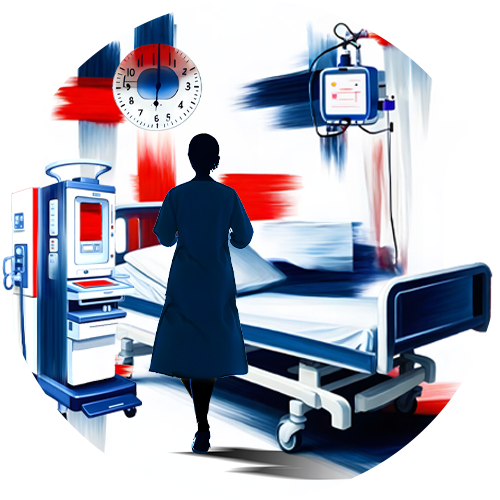On Call — Chapter 18: Possibilities
| August 6, 2024While there are quiet times in the ER, anyone with experience knows they don’t last long

“IT looks pretty quiet here,” the newest resident says to me, surveying the sparsely populated ER waiting room. She is all shiny and new, straight from med school, and I feel like it’s been years since I was so untested, so eager, and so clueless. Three years of residency can do that to a girl.
“Don’t say that!” comes the sharp exclamation from behind. I spin around to see Nicole, one of the night nurses, just coming off her shift.
“Say what?” New Resident is confused.
“It’s a thing in the ER,” I explain. “Never says it’s quiet, because soon it won’t be!” The truth? It’s not a superstition, but reality. While there are quiet times in the ER, anyone with experience knows they don’t last long.
It doesn’t.
The ambulance phone line begins to ring just as a frantic man bursts through the front door, a small, still bundle over his shoulder. I barely catch a glimpse of the pale, anxious mother as he begins to speak urgently to the nurse at the desk. The bundle over his shoulder? When I look more closely, I can see a shock of curly red hair blazing against the man’s gray sweater. A toddler.
I get an even closer look when I’m assigned to their room.
“Good morning, I’m Dr. Rubin,” I say briskly, striding inside. “From what I see on the report, it looks like your daughter is not being responsive? You think she may have fallen?”
“My teenage daughter was watching Cassie outside while I was finishing up some work.” The mother speaks in a rush, and I notice her hands are so tightly clasped they look like paper cutouts. She’s terrified, trying to hide it. “And then she came in screaming — my teenager — yelling that Cassie was lying on the grass and wouldn’t answer her. I rushed outside and Cassie was just sprawled in our yard, and we don’t know if maybe she fell on her head and got injured or if something else happened.” She’s running out of air. Stops. Keeps going. “I kept asking her if something hurts her, but Cassie wouldn’t open her eyes or answer me. She’s usually so happy and chatty and— I just don’t know what’s going on!” She’s blinking away the tears, and I bend down to examine the little girl.
“Cassie,” I say soothingly. “Can you tell me if something hurts?”
There’s no answer. As I gently push aside the red curls to take a look at her scalp, Cassie squirms and clenches her fists. I can’t find any outward signs of trauma on her head, but Cassie’s eyes are still tightly closed, mouth tight. I try to open one of her eyelids to see if her pupils are dilating properly, but she starts thrashing around, and I don’t want to hurt her. Something is clearly bothering her. In the pale face, the freckles standing out like splatters of paint, I see fear and discomfort. But Cassie won’t talk.
“What’s wrong, doctor?” Cassie’s father asks.
“I don’t see any signs that she fell, but I want to rule out that possibility,” I tell the parents. No need to explain that I’m baffled. Figuring out what’s wrong with patients, especially children, can sometimes be like beginning a puzzle. The pieces are spread out in front of me, and I need to figure out how everything fits together. Sometimes it’s immediately clear; sometimes it takes more time. And sometimes, I never do know exactly what happened. I hope this won’t be one of those times. “We’re going to do some bloodwork, and we’ll take an MRI. If those are fine, then we’ll look into other possibilities.”
As Cassie’s red hair is disappearing into the gaping mouth of the MRI machine upstairs, I receive the results from her bloodwork. Normal. Something’s not adding up here, but I need to see the MRI scans to confirm my suspicions that Cassie’s problem has nothing to do with a fall. Within 20 minutes, I’m looking at the scans. I’m not a radiologist, but everything seems perfectly fine, and when the radiologist does speak to me, he agrees with my assessment.
Cassie is back in the room, eyes still shut, discomfort etched on her small face. Her parents look at me with hope, and I hate the helpless feeling of not knowing and not being able to help these distraught people.
“What’s the problem, Dr. Rubin?” Cassie’s mother asks, a slight wobble in her voice.
I’m looking at Cassie in frustration, trying to think, because what is wrong with this little girl? What am I missing? I’m about to admit that I have no clue, and maybe we need a second opinion, when I suddenly notice something I didn’t see before: tears coming out of one eye. A steady trickle of tears glistens down the right side of her face. How did I miss that? I don’t know, but in my mind, there’s the sudden triumphant click of the symptoms slotting into place.
“There are no signs of a head injury, and her bloodwork is completely normal,” I say reassuringly. “But I think I know what’s causing the issue, and it’s not serious at all. Hold Cassie’s head,” I instruct her father. “I’m going to put one drop of numbing eye drops into her right eye.”
He holds her head, and I take a small bottle from a drawer. I time it swiftly — a flick upward, a sharp squeeze, and the drop is in her eye before she can blink. Another numbing drop on a strip of orange paper, and I wait a moment until the dye has colored the liquid. I rub the wet orange paper on the bottom of Cassie’s eye, and even though she protests, her father keeps her still.
“Now I’m going to shine a UV light into her eye,” I say, and with the air of a conjuror, pull over the wood lamp in the corner, pry open Cassie’s lid, and switch on the light. Even her parents can see it.
“There’s a scratch on her eye! I can see it against the orange dye!” her mother says in wonder.
“A scratch on the cornea can be extremely painful,” I tell her, rummaging around for antibiotic cream. “We’ll never know exactly how it happened, but Cassie was probably frightened and uncomfortable, and didn’t know how to tell you what happened. I’m going to put a little bit of this polymyxin in her eye, and we’ll talk about how you’ll continue the treatment at home.” I squeeze some cream into Cassie’s eye, and am rewarded by a blink, and then another. Cassie looks around, gently touches her eyelid, and stares up.
“No more boo-boo!” she informs me, wonderingly. And then she laughs in amazement. This tiny little girl, who was frozen with fear only a moment ago, is now giggling, face shining with glee. We look at each other, and suddenly we’re laughing together with Cassie. There’s a sense of relief, and tears spring to my eyes at the miraculous transformation from silence and pain to beautiful, infectious laughter.
Every day I’m on call, every day I walk these corridors, I’m given the gift of healing and hope. And even when I can’t save my patients’ lives, I can give them dignity and compassion. The ER is draining and exhausting, sometimes frightening and sad, but underneath it all, I know I’m doing something essential. I don’t know many other jobs that are so fundamentally important, so close to the heart of what it means to be human — messy and hard and beautiful and painful and hopeful, all at the same time.
Cassie is still laughing, and my heart is full. It’s not every day that a problem is so easily fixed, that tears become joy, but the ER is a place where anything is possible.
THE END
The characters in this series are composites; all the stories are true.
(Originally featured in Family First, Issue 905)
Oops! We could not locate your form.


